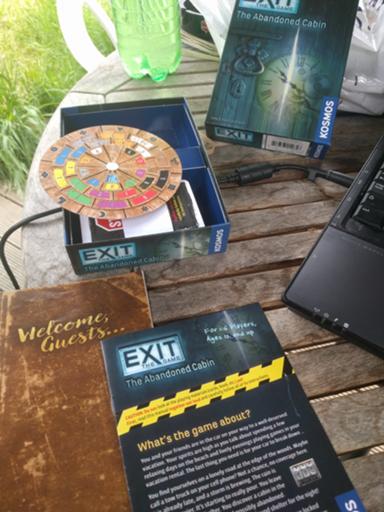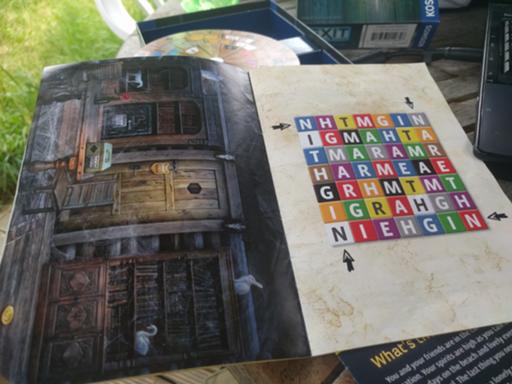I borrowed a copy of Inka and Markus Brand's
Exit: The Abandoned Cabin,
one of the many recent escape-room-in-a-box games. (I will not reveal
anything that's not immediately available when you start playing.)
The box contains three decks of cards (Riddles, Answers and
Help), a four-part Secret Decoder Wheel, and three Mysterious Items
(coloured cards with holes punched in them). There's also an
instruction book and a clue book.

The clue book contains various puzzle elements which didn't fit on the
cards.

You start with one puzzle card, and when you solve it you get more.
Each solution takes the form of a symbol (associated, in principle,
with a particular locked item), and three numbers (or colours). Line
up the four things on the decoder wheel and you get an answer number;
check that answer card for the item you were trying to open (which you
must already have revealed), and, if you might be right, it'll point
you to another answer card, which will either tell you you're wrong or
give you more riddles to solve.
Some of the puzzles are fairly straightforward; others are more
complex, needing sideways thought, and sometimes materials gained from
the solution of multiple prior puzzles. As with all sets of puzzles,
once you start to realise how the writers think it all becomes much
easier; I found I started reasonably quickly, bogged down a little in
the middle as the puzzles got harder, but raced through the last few.
Interestingly, there's no way to lose (perhaps because you can only
play once); you get fewer "stars" if you take longer or use more help
cards, but you still get to experience the entire game.
The help cards (hints) are in three steps: usually the first one tells you
which other cards you'll need to solve the puzzle, the second tells
you how to go about doing it, and the third has the answer.
Some of the ways in which the cards are used can be quite awkward; one
is encouraged to cut them up, for example. I can see that this would
contribute to game sales, but since it's otherwise entirely easy to
re-set the game for a new player, it seems wasteful. Only one puzzle
is made particularly challenging by being non-destructive, and there's
a loophole for it anyway. (I gather that later games in this series
are harder to play without making irreversible changes.)
All in all, it's quite fun. I wouldn't have bought it before I'd
played it, and of course since one can only solve the puzzles once I'm
not going to buy it now – but perhaps more to the point I'm not going
to rush out and buy other Exit games, though I'll be happy to play
more if they come my way. At £13 for under an hour's entertainment
it's more expensive than beer or even films. (And the better you are
at it, or the more people are working in parallel, the less time you
spend playing…)
Comments on this post are now closed. If you have particular grounds for adding a late comment, comment on a more recent post quoting the URL of this one.